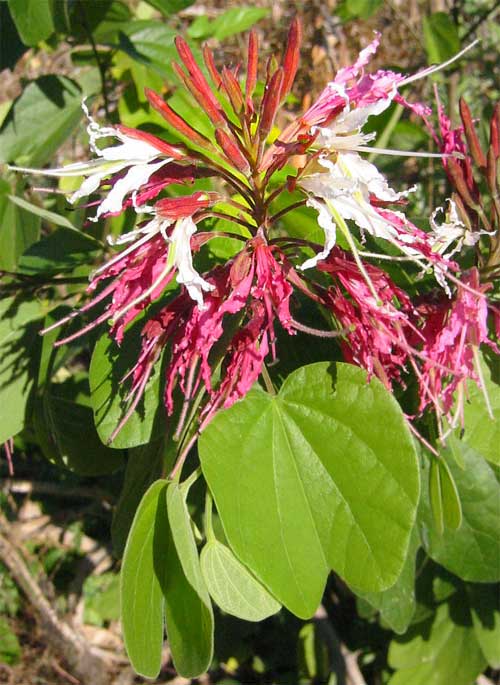Excerpts from Jim Conrad's
Naturalist Newsletter
from the March 10, 2008 Newsletter written in the community of 28 de Junio, in the Central Valley 8 kms west of Pujiltic, elev. ~700m (2300ft), ~N16.331°, ~W92.472°; southeastern Chiapas state, MÉXICO
COWFOOTS FLOWERING
A common, pretty bush flowering nowadays in disturbed areas is a Bean Family member belonging to a genus whose members are often known in Spanish as Pata de Vacas, or cowfoots. The cowfoot genus is BAUHINIA. You'll understand where the cowfoot name comes from when the see the roundish, cleft leaves shown below:

I'm always tickled to see those cowfoot-shaped leaves because they announce the genus Bauhinia with such certainty. I know of no other group of plants with such a leaf shape. Breedlove's Flora of Chiapas lists over 600 species belonging to the Bean Family, the vast majority producing compound, sometimes twice- or thrice-compound, often look-alike leaves, but only the twelve Bauhinia species listed for Chiapas have those cowfoot leaves.
Bauhinia's pretty flowers are a little reminiscent of the North's unrelated honeysuckles. For one thing, the newly opened, not-yet-pollinated flowers are white, but once they've been pollinated they quickly turn reddish. When honeysuckle blossoms are pollinated they turn yellow. In both cases, the already-pollinated flowers are less bright than the white ones, thus helping focus the attention of pollinating insects on blossoms still needing to be visited.
This Bauhinia species is a vigorous, aggressive weed here. It grows so fast that it turns up in cornfields head-high and flowering after being established there only since the last planting season. Sometimes downslope from a mother tree you see dozens of younger plants forming a thicket, where a relatively high percentage of the parent's seeds have germinated.
One gets a feeling that if the Earth undergoes the catastrophic environmental collapse many foresee because of global warming, this tough little Bauhinia species might be one of a few species surviving, and for that sake alone I'm glad it has such pretty flowers. The people who come after us are going to need all the loveliness in their lives they can get.